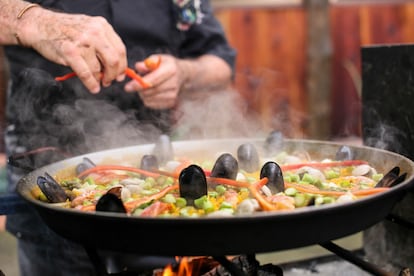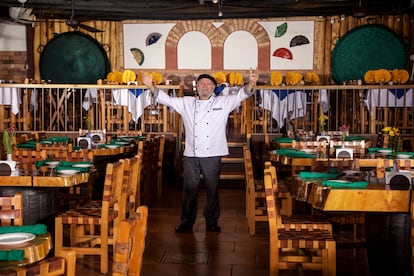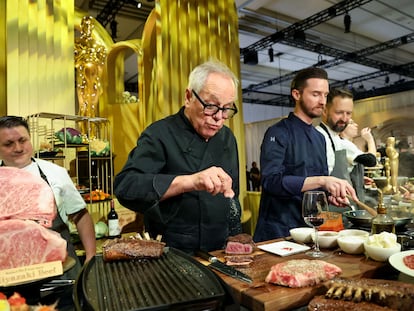Vicente Aguilar Cerezo, the self-taught chef from Spain whose paellas draw crowds in Costa Rica
People are willing to drive for over an hour for a table at La Lluna de Valencia, whose owner has been serving Spanish food for 28 years in a place that people once said was ‘the least suitable’ for a restaurant. Photos of presidents now line the walls


“Don Vicente, you’re looking very well!” says an older woman holding the menu in her hands. Over at the next table, a young man interrupts his conversation to stand up and shake his hand: “Don Vicente, I saw you on TV the other day!” Vicente Aguilar Cerezo, 76, walks across his restaurant, La Lluna de Valencia, and makes sure to personally greet all his first customers of the day in the enormous main room of this stately building that is more than 100 years old and once served as an aristocratic residence. “It has the old-fashioned flavor of a landowner’s house from this region,” says Aguilar.
The region in question is Santa Bárbara, a coffee-growing town of about 6,000 inhabitants, tucked beneath the mountains on the outskirts of the Costa Rica metropolitan area. But the food is, like its owner, 100% from Spain. On the day of this visit, Don Vicente is offering steak and shrimp as the specials of the day and, like he has done every Sunday for almost three decades, he is working on a huge paella for dozens of people.
As a native of the Valencia region of Spain, rice dishes are his specialty. He has been preparing them for 28 years in the same location, which might be considered unusual for a restaurant of this nature. “I started out all alone here; no one believed I would make it. They told me that it was the least suitable place to open a restaurant,” says the chef, who is expecting to serve about 150 people today, although it could be even more. The previous Sunday, he says, the place was filled with 180 customers.
Santa Bárbara is not a central location to travel to from the city, but many customers are willing to drive up to an hour or more from the capital, San José, to try the food. “Everyone has been here, even presidents, former presidents, politicians and businessmen,” he says, showing the photos that decorate the room.

Vicente Aguilar was born in “a small town near Valencia,” although he hesitates to specify the exact location: “Sometimes I don’t know if it is Alboraya, which is a town known for its tiger nuts, or if I am from Meliana. But hey, there is an orchard between those two towns. I was born there,” he specifies. He never received any professional training in cooking. He learned, he says, from his parents and grandparents, as one of the housework tasks. “From the age of five I made breakfast for my grandfather, and from there comes a little of my love for cooking,” he explains.
Vicente does not like the word “chef,” which he says is a “a little too big” for him. He prefers to describe himself as an “artisan” because, like his younger brother, Toni, who has a restaurant in Valencia called Barraca de Toni Montoliu, he is self-taught.

When La Lluna de Valencia opened, Vicente had never even cooked in a restaurant. He arrived in Costa Rica in 1982, working as a consultant for United Nations projects in Central America and the Caribbean. Before that he had lived in Honduras, El Salvador, Nicaragua and the Dominican Republic. It was that experience that got him hooked on Central America, he says. When his second child was born, he decided to move to Costa Rica because the political situation in the rest of the region was “quite difficult.” “Costa Rica offered all the advantages of living with a family. It is a country that does not have an army and it shows. The people here are calm and nice,” he says. Vicente quickly detected an important gastronomic similarity between his native Valencia and his new home: “Costa Ricans and Valencians have in common that we can eat rice in the morning, at noon and at night. Here they have the gallo pinto and the casado and they eat a lot, and I mean a lot of rice.”

In 1996, with his consulting days behind him, he bought a plot of land in Santa Barbara and embarked on a new venture in the world of international cuisine. He says that at that time there were very few Spanish restaurants in the country, and that several closed over the years. “For a long time I remained the reference for Spanish cuisine.”
Of the pioneers of Spanish food that were operating around that time, only La Lluna de Valencia and another restaurant called Costa del Sol remain; the latter is located in the province of Puntarenas, on the Pacific coast, more than three hours by car from Santa Bárbara. In recent years, however, new venues have begun to pop up in San José. “All establishments currently in Costa Rica work at a very high level, but there is no Spanish restaurant that is older than mine,” he notes.
Aguilar emphasizes the word “Spanish” as opposed to “Valencian” because his restaurant serves a little bit of everything, from Galicia-style octopus to Madrid’s classic callos (made with tripe) and Córdoba-style oxtail. He says that, with the growth of Spain as a tourist destination, it is increasingly common for Costa Ricans to be familiar with Spanish cuisine and ask for a dish that is not on the menu. “They tell me: ‘Vicente, can’t you make some huevos rotos?’” The biggest star of the menu, however, still is and always has been paella. What “80% or 90%” of customers order is paella, which costs the equivalent in colones (the local currency) of about $32. Tapas range between approximately $13 and $17.

While supervising the wood-fired paella prepared by one of the cooks, Aguilar assures that it tastes just like one made in Spain. In Costa Rica it is possible to find Bomba rice from the famous rice-growing Albufera region of Valencia (for almost six times the price of national rice) and most of the other ingredients as well. From the garden at the entrance he gets almost all the condiments he needs, and there is very little that he needs to order from abroad, the exception being saffron. As for seafood, he explains that the hot waters of the tropics produce a less salty flavor than the fresh waters of the Mediterranean, so he must season the local product more to give it the same flavor.
His paella has earned him recognition in his homeland. The walls of the room are decorated with the third place prize of the 2017 Sueca International Valencian Paella Competition, the 2020 Golden Spoon of the Valencian Community and the first place of the 2022 Paella Festival.
He won the awards in Valencia, but the prizes traveled to Costa Rica with him because he feels from both places. “They have already changed my name. Now I am ‘Vicentico’ (‘Ticos’ is the nickname that Costa Ricans are known by), I have Costa Rican nationality and I feel very proud that Costa Rica opened its arms to me. I live in a blessed country that has no army. I have learned a lot from their idiosyncrasies and I feel I have contributed something from Spanish culture,” he says.
Sign up for our weekly newsletter to get more English-language news coverage from EL PAÍS USA Edition
Tu suscripción se está usando en otro dispositivo
¿Quieres añadir otro usuario a tu suscripción?
Si continúas leyendo en este dispositivo, no se podrá leer en el otro.
FlechaTu suscripción se está usando en otro dispositivo y solo puedes acceder a EL PAÍS desde un dispositivo a la vez.
Si quieres compartir tu cuenta, cambia tu suscripción a la modalidad Premium, así podrás añadir otro usuario. Cada uno accederá con su propia cuenta de email, lo que os permitirá personalizar vuestra experiencia en EL PAÍS.
¿Tienes una suscripción de empresa? Accede aquí para contratar más cuentas.
En el caso de no saber quién está usando tu cuenta, te recomendamos cambiar tu contraseña aquí.
Si decides continuar compartiendo tu cuenta, este mensaje se mostrará en tu dispositivo y en el de la otra persona que está usando tu cuenta de forma indefinida, afectando a tu experiencia de lectura. Puedes consultar aquí los términos y condiciones de la suscripción digital.
More information
Archived In
Últimas noticias
Most viewed
- Oona Chaplin: ‘I told James Cameron that I was living in a treehouse and starting a permaculture project with a friend’
- Reinhard Genzel, Nobel laureate in physics: ‘One-minute videos will never give you the truth’
- Sinaloa Cartel war is taking its toll on Los Chapitos
- Why the price of coffee has skyrocketed: from Brazilian plantations to specialty coffee houses
- Silver prices are going crazy: This is what’s fueling the rally









































